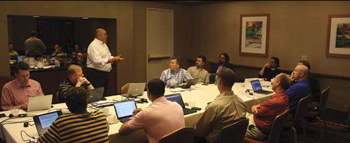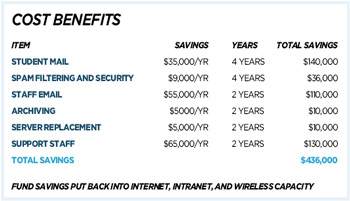The Cloud

When it comes to running a district’s online operations, the general consensus of this working group was not answering the questions “if?” or “why?” go with a cloud-based strategy but “when?” and “how best?” Each presenter had distinct visions, concerns, costs, and applications. Some opted for closed strategies using software that comes with costs. Others chose open systems with services that are free. All participants agreed that this information infrastructure, no matter if you call it “the cloud” or not, is an essential element of any district IT vision. Here are some takeaways from the conversation:
Burrillville, RI School Department
Presenter: Paul Barrette, Director of Technology
His suggestions for implementing: Project-based utilization of cloud tools can drive adoption and be sure to involve lots of stakeholders in planning and implementation.
First, some realizations: Online features and functions can be as much a frustration as a benefit. Some cloud tools are useless if they are not being used online, and not all Web browsers are created equal. Some pleasant surprises: Adoption by the staff was swift, concerns from parents were almost non-existent, and the cloud infrastructure was essential during a recent weather emergency.
Tools They Use
Chromebooks
iPads
Refurbished desktops
NComputing L300 solution
Google Apps
MMS Generations SIS
Study Island
WHERE TO START
Tools and ideas to transform education. Sign up below.
• Develop a vision for how this fits with your district’s goals (college readiness, parent participation)
• Assess your network. What parts can you do in-house?
• Don’t try to build the entire cloud environment in one project. Even the big boys don’t do this.
• Choose a few applications and services that will have the biggest impact. Look for lowhanging fruit.
• Develop a good sales pitch. This is not an easy concept to sell.
—Robert Gravina
Maine Township, 207 (IL)
Presenters: Dr. Ken Wallace, Superintendent and Dr. Henry C. Thiele, CTO
Going with open solutions doesn’t necessarily mean sacrificing quality or security. Early adopter of the cloud since 2007, Thiele says the school’s culture has become more collaborative and flexible since implementing the cloud. It removes walls, actually closes the digital divide, and increases demands for other technologies. Another myth buster: just because it is free doesn’t mean students are being served advertisements. Wallace says the trick is taking traditional institutions and making them more nimble. Doing that involves supporting the staff that ultimately leads that transformation in the day-to-day business of running schools.

Tools They Use
Google Apps
Aspen SIS
School Messenger
Palo Alto Web Filter
Mediacast
Eduphoria
Discovery Streaming
Gale
Follet Destiny & TetraData
Brain Pop
Naviance
Education 2020
Poway Unified School District
Robert Gravina, Chief Information and Technology Officer
“We use our cloud to help teachers and students set goals. Walk into any one of our 1st and 2nd grade classrooms and students will tell you not only what they need to learn, but how they are learning it.” — Robert Gravina
Develop a vision for how the cloud fits with your district’s goals such as college readiness and parent participation. Assess your network and ask yourself what parts of the implementation can you do in-house and what do you need to outsource. Also, don’t try to build the entire cloud environment in one project—choose a few applications and services that will have the biggest impact. Most important: Develop a good sales pitch as this is not an easy concept to sell at first.
Tools They Use
Cisco Shop
Dell Desktops & servers (we are 95% virtualized using VMWare).
Lenovo Laptops
Apple Tablets
Blackboard
MAP (from NWEA)
Compass Learning
Stoneware
Judson ISD, San Antonio, TX
Presenter: Steve Young, CTO
Your best arguments for implementing the cloud: Very high up time, recurring costs are low and predictable, technical barriers are low, and you can implement without additional staff. Best reason for using Software as a Service (SaaS) cloud solution: Deployments can be extremely efficient and cost effective. Using our Stoneware web portal as a gateway to SaaS clouds, users get an easy one-stop shop for all their applications from anywhere on any device. Creating, updating, and retiring of student and staff accounts over multiple cloud systems automatically through our UMRA identity management solution means huge time savings.
Tools They Use
Stoneware
Schoology LMS
Cisco wireless
Live@Edu
nComputing X & M Series
nComputing L series and Citrix Xenapp virtual desktops
“The easy part is the wires, bolts, bits and bytes. The hard part is controlling the policies and procedures to protect the district from liabilities.”
Greg Partch, Hudson Falls Central School District, NY
Additional Participants:
Leo Brehm
Director of Information Technology, Newton Public Schools, MA
Bryan Doyle
Director of Information Technology Services, Bastrop ISD, TX
Salvador Contes, Jr.
Director of Technology, Poughkeepsie City School District, NY
Jim Klein
Director Information Services & Technology, Saugus Union School District, CA
David Harding
Superintendent, Willington Public Schools, CT
